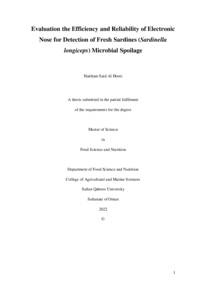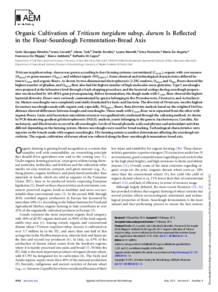Document
Evaluation the efficiency and reliability of electronic nose for detection of fresh sardines (Sardinella longiceps) microbial spoilage.
Other titles
تقييم كفاءة واعتمادية الأنف الإلكتروني لمعرفة الفساد الميكروبي للسردين الطازج
Publisher
Sultan Qaboos University.
Gregorian
2022
Language
English
English abstract
The assessment of fish microbial spoilage is a major fish industry interest to minimize
the loss and increase the productivity of the catch. The existing spoilage assessment
methods are time and labour-consuming. Thus, developing a rapid method to detect
fish spoilage remains an essential requirement of the fish industry to minimize fish
catch loss and facilitate its marketing. This study aims to evaluate the efficiency and
reliability of the electronic nose (E-nose) to detect fish microbial spoilage in
comparison with the conventional methods using fresh sardines (Sardinella
longiceps). The efficiency and reliability of E-nose were evaluated by comparison
with three parameters; total bacterial count (TBC), hydrogen sulfide (H2S) producing
bacterial count and trimethylamine oxide (TMAO) reducing bacterial count in six
storage studies (i.e. six different lots) divided into two temperatures (0oC and 25oC).
Total bacteria were enumerated on tryptone soya agar, whereas iron agar and TMAO
agar were used to enumerate H2S producing bacteria and TMAO reducing bacteria
respectively. Principle component analysis (PCA), linear discriminant analysis (LDA)
and artificial neural network (ANN) were used to demonstrate the E-nose data.
Significant changes in TBC and H2S producing bacterial count occurred between 4
and 6 days of sardines stored at 0oC. However, significant changes of TMAO
reducing bacterial count were found between 2 and 4 days of storage. On the other
hand, changes in TBC and TMAO reducing bacterial count were significant between
3 and 6 h of storage at 25oC, while the count of H2S producing bacteria showed
significant changes between 6 and 9 h of storage. At the end of storage at 0oC, the
count of TBC, TMAO reducing bacterial count and H2S producing bacterial counts
were 6.25, 5.5 and 5.6 log CFU/g respectively. In contrast, the counts were 5.79, 4.98
and 4.80 log CFU/g for TBC, TMAO reducing bacteria and H2S producing bacteria
respectively at the end of storage at 25oC. The LDA and ANN showed a good
classification of E-nose data for different storage times at two storage temperatures
(0oC and 25oC). However, PCA classified was less efficient than LDA and ANN in
spoilage of fresh sardines. Correlation coefficients between E-nose and TBC, TMAO
reducing bacterial count and H2S producing bacterial count at 0oC were 0.919, 0.960
and 0.915 respectively. However, at 25oC, the correlation coefficients were 0.859,
0.945 and 0.849. In conclusion, a high positive correlation was found between E-nose
and all microbial groups which qualifies the E-nose as an efficient device in the
detection of fresh sardine's microbial spoilage at different storage temperatures.
Member of
Resource URL
Arabic abstract
عتبر تقييم الفساد الميكروبيولوجي لألسماك أحد اهتمامات التصنيع السمكي لتقليل الفاقد وزيادة الإنتاجية. تعتبر طرق تقييم الفساد الحالية مستهلكة للوقت والعمالة. لذلك، فإن تطوير طريقة سريعة لمعرفة فساد الأسماك يبقى من الضروريات المهمة لمصانع الأسماك لتقليل الخسائر في المصائد وتسهيل تسويقها. تهدف هذه الدراسة إلى تقييم كفاءة الأنف الألكتروني واعتماده كطريقة لمعرفة الفساد الميكروبيولوجي لألسماك وذلك بمقارنته مع الطرق التقليدية باستخدام سمك السردين الطازج )ساردينال لونجيسبس(. كفاءة واعتمادية الأنف الألكتروني قيمت من مقارنته مع معايير: العد البكتيري الكلي TBC، وعد البكتيريا المنتجة لكبريت الهيدروجين )S2H)، وعد البكتيريا المختزلة لثلاثي ميثيل أمين أكسيد )TMAO )في ست دراسات تخزينية )دفعات( ومقسمة على درجتين حراريتين )0 درجة مئوية و25 درجة مئوية(. البكتيريا الكلية عدت في آجار تربتيكيز الصويا، بينما آجار الحديد وآجار لثلاثي ميثيل أمين أكسيد استخدمت لعد البكتيريا المنتجة لـS2H وعد البكتيريا المختزلة لـ TMAO على التوالي. استخدم تحليل العنصر الرئيسي )PCA )وتحليل التمييز الخطي )LDA )وشبكة عصبونية اصطناعية )ANN )لشرح بيانات الأنف الألكتروني. بينت الدراسة أن التغيير الجذري في TBC وعد البكتيريا المنتجة لـ S2H حدث بين اليومين الرابع والسادس للتخزين على درجة حرارة 0 درجة مئوية، كان التغيير الجذري لعد البكتيريا المختزلة لـ TMAO بين اليومين الثاني والرابع من تخزين السردين. من جهة أخرى، فإن التغييرات في TBC وعد البكتيريا المختزلة لـ TMAO كانت جذرية بين ثالث ساعات وست ساعات من تخزين السردين على درجة حرارة 25 درجة مئوية بينما العد البكتيري للبكتيريا المنتجة لـS2H أظهر تغييرا جذريا بين ست ساعات وتسع ساعات من التخزين. في نهاية التخزين على درجة حرارة 0 درجة مئوية، كان العد لـ TBC والبكتيريا المختزلة لـ TMAO والبكتيريا المنتجة لـS2H 6.25 و5.50 و5.60 لوغاريتم لكل جرام على التوالي. في المقابل، العد كان 5.79 و4.98 و4.80 لوغاريتم لكل جرام لـTBC ، وعد البكتيريا المنتجة ل S2H، وعد البكتيريا المختزلة TMAO على التوالي للسردين المخزن عند درجة الحرارة 25 درجة مئوية بعد تصنيفا جيد تسع ساعات. أظهر LDAوANN ا لبيانات الأنف الألكتروني لمختلف أوقات التخزين على درجتي الحرارة )0 درجة مئوية و25 درجة مئوية(. لكن PCA أظهر كفاءة أقل في تصنيف بيانات الأنف الألكتروني من LDA و ANN. معامل الأرتباط لألنف الألكتروني مع TBC، وعد البكتيريا المنتجة لـ S2H، وعد البكتيريا المختزلة لـTMAO في درجة حرارة 0 درجة مئوية كان 0.92 و0.96 و0.92 على التوالي. لكنه كان 0.86 و0.95 و0.85 في السردين المخزن على درجة حرارة 25 درجة مئوية. ختاما ، وجدت هذه الدراسة عالقة إيجابية قوية بين نتائج الأنف الألكتروني وكل مجموعات العد الميكروبيولوجي والذي بدوره يؤهل الأنف الألكتروني ليكون جهازا ذا كفاءة عالية في كشف الفساد الميكروبيولوجي للسردين الطازج على مختلف درجات حرارة التخزين.
Category
Theses and Dissertations


